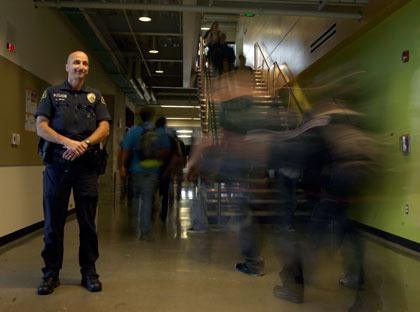MARYSVILLE — While their uniforms might be intimidating to some, the Marysville School Resource Officers want the community to know that they’re there to help serve the needs of school district staff, parents and students.
Starting this school year, the Marysville School District expanded its School Resource Officer program with the Marysville Police Department to put Officer Dave White at Marysville Getchell High School, Officer Bronwyn Kieland at Mountain View High School and Cedarcrest Middle School, Officer Wallace Forslof at Marysville-Pilchuck High School and Officer Molly Ingram at the Totem and Marysville middle schools. SROs deal primarily with law enforcement problems that arise within schools or the school jurisdictions, and investigate and make arrests when appropriate.
“SROs are trained police on campus who promote a positive image through interaction with students, parents, teachers and administrators,” Marysville Police Chief Rick Smith said. “The goal is to help create a safer environment in the school and surrounding neighborhoods.”
Marysville School District and Police Department representatives explained that their respective agencies will each be paying half, or roughly $186,000, of the total salaries, benefits packages and anticipated overtime costs of the SROs. Jodi Runyon, administrative assistant to the superintendent, noted that this does not represent an increase for the school district, since they’d previously had an interlocal agreement with Snohomish County for the schools in the central Marysville annexation area. Marysville Police Cmdr. Robb Lamoureux added that the police department is applying for a U.S. Department of Justice grant that could pay for two of the SROs.
At the Marysville Getchell High School campus, White has settled into his new surroundings. A 20-year veteran of the force who’s served as an SRO for the past year and a half, White believes that SROs’ visibility in the schools not only serves as a visual deterrent to crimes and other offenses, but also makes the police appear more approachable. He agreed with Marysville Police Lt. Jeff Goldman that the schools’ administrators are still in charge, and that SROs respect their rules and engage in frequent discussions with them.
“The schools’ administration and security personnel play a big part too,” White said. “They do a lot of the disciplinary and preliminary investigation work, which we help to process through. The other morning, I’d heard rumors that a student might be doing something they shouldn’t, so I talked to them about their behavior. Rather than responding after the fact, SROs can develop relationships with students that can preempt such incidents.”
Academy of Construction and Engineering Principal Shawn Stevenson expressed strong support for SROs such as White, whose office is located in the ACE Small Learning Community building. He echoed Goldman’s view that SROs and school staff work as teams to help drive down incidents on school campuses, and even suggested that SROs could have an educational impact as well.
“Civics classes benefit when they can utilize people in those professions to answer students’ questions about how the systems they’re studying work in the real world,” Stevenson said. “It can be difficult to get a police officer off the road to come talk to kids, but if they’re already right here, it’s easier for teachers to request them as guest speakers.”
“I’d love to see the SROs partner with the teachers that way,” Goldman said. “Both the students and the officers get excited when they’re able to interact like that.”
SROs respond to the same types of crimes on school campuses that they would around the community, including assault, fighting, drug and alcohol complaints, vandalism, gang activity, intimidation and harassment, burglary and trespassing. Statistics compiled by Marysville Police Crime Analyst Don Castanares for the 2008-09 and 2009-10 school years shows that incidents of vandalism fell by 59 percent, from 127 to 52, while assaults dropped by 40 percent, from 100 to 60, and reports of gang activity went from 86 down to 66, a 24 percent decline. Overall, the total incidents in the 2008-09 school year decreased to 847 in the 2009-10 school year, a drop of 16.5 percent.



